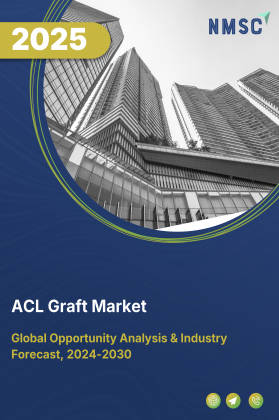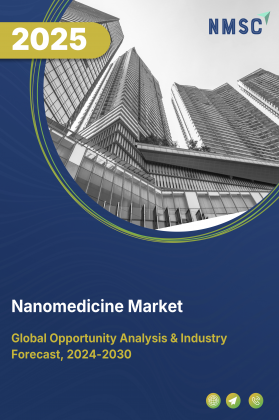
ACL Graft Market by Material (Biological Materials and Synthetic Materials), by Graft Type (Autograft, Allograft, Synthetic and Others), by Technology (Robotic-Assisted Surgery and Conventional Surgery), by Fixation Type (Femoral Fixation and Tibial Fixation), by Application (Knee Ligament Reconstruction, Chronic ACL Deficiency, and Others), and by End Users (Hospitals, Ambulatory Surgical Centers, and Orthopedic Clinics) – Global Opportunity Analysis and Industry Forecast 2025 – 2030
ACL Graft Industry Overview
The global ACL Graft Market size was valued at USD 199.05 million in 2024, with an estimation of USD 214.58 million in 2025 and is predicted to reach USD 312.58 million by 2030 with a CAGR of 7.8% from 2025-2030.
The ACL graft market is experiencing steady growth, driven by the expanding elderly population, rising participation in high-impact sports, and the increasing prevalence of degenerative knee conditions. Aging individuals face a greater risk of ACL injuries due to musculoskeletal degeneration and reduced ligament strength, while active lifestyles among both younger and older populations contribute to higher injury rates. The burden of chronic knee disorders further fuels the need for durable and high-performance graft solutions that restore mobility and improve quality of life.
However, market expansion is tempered by risks and complications associated with post-surgery recovery, which influence patient decisions. On the other hand, the emergence of advanced synthetic grafts presents significant opportunities, offering enhanced stability, faster rehabilitation, and better long-term outcomes. Leading players are focusing on innovation and strategic product launches to strengthen their market presence, positioning ACL grafts as an essential component of modern sports medicine and orthopedic treatment.
Growing Aging Population Drives ACL Graft Market Growth
The growing elderly population is a major driver of industry expansion, as aging increases the prevalence of musculoskeletal injuries. According to the WHO, the global population aged 60 and above is projected to rise from 1 billion in 2020 to 1.4 billion, and will double to 2.1 billion by 2050. Within the same period, the number of individuals aged 80 and above is expected to triple, reaching 426 million.
With age comes greater susceptibility to musculoskeletal degeneration, reduced bone density, and ligament fragility factors that heighten the risk of anterior cruciate ligament (ACL) injuries. While such injuries were once primarily associated with younger, athletic individuals, they are becoming increasingly common among older adults due to active lifestyles, participation in recreational sports, and fall-related incidents. As natural healing processes slow with age, surgical solutions like ACL reconstruction become more necessary in this demographic. Additionally, advancements in graft materials and surgical techniques tailored for older patients are boosting demand by enabling faster recovery times and enhanced joint stability.
Rising Sports Participation and Injury Incidence Fuels the ACL Graft Market Demand
The growing popularity of sports and recreational physical activities is a key driver for the market. As more individuals, particularly youth and amateur athletes, engage in high intensity and contact sports, the likelihood of sustaining anterior cruciate ligament injuries increases. Sports such as football, basketball, skiing, and soccer place significant strain on the knee, making the ACL particularly vulnerable to tears and ruptures.
This trend is not limited to developed countries emerging economies are also experiencing higher participation rates due to fitness awareness campaigns, school-level sports programs, and government initiatives promoting active lifestyles. Consequently, the rise in injury incidence is translating into greater demand for ACL reconstruction procedures. This, in turn, is fueling the ACL graft market for advanced sports injury treatment materials and surgical techniques that can provide quicker recovery, stronger ligament integration, and improved long-term outcomes for patients.
Rising Prevalence of Osteoarthritis and Knee Degeneration Boosts the ACL Graft Market Trends
The increasing prevalence of osteoarthritis and age-related knee degeneration is emerging as a key driver for the ACL graft market. Chronic knee conditions weaken ligaments and increase susceptibility to ACL tears, particularly in middle-aged and elderly populations. As joint degeneration progresses, patients are more likely to require surgical interventions such as ACL reconstruction to restore mobility and improve quality of life. The growing burden of degenerative knee disorders is also pushing demand for patellar tendon graft materials designed to provide enhanced biomechanical strength and long-term stability, further fueling market expansion.
Risks Related with Post-Surgery Restricts the ACL Graft Market Expansion
The ACL graft market faces notable restraints due to the potential risks and complications associated with post-surgical recovery. Patients encounter challenges such as infection, graft failure, joint stiffness, or extended rehabilitation timelines, which impact overall treatment success. In some instances, revision surgeries required, adding to the physical and emotional strain on patients. These post-operative concerns create hesitation among individuals considering ACL reconstruction, particularly those with underlying health conditions. As a result, the perceived uncertainty surrounding surgical outcomes acts as a barrier to wider adoption, limiting the market’s growth potential.
Integration of Synthetic Grafts Creates Future Opportunities
The growing adoption of synthetic grafts presents a significant opportunity for the ACL graft market. Unlike traditional autografts or allografts, synthetic options offer the advantages of consistent quality, reduced dependency on donor tissue, and elimination of donor site morbidity.
Advances in biomaterials have led to synthetic grafts that closely mimic the strength, flexibility, and biological compatibility of natural ligaments, while supporting faster recovery and lower complication rates. Their potential to address the limitations of conventional grafts such as limited availability and risk of disease transmission positions them as a promising alternative in ACL reconstruction. As research and clinical trials continue to validate their safety and performance, the integration of synthetic grafts is expected to open new avenues for innovation, broaden surgical choices for physicians, and expand the market’s growth potential.
Market Segmentations and Scope of the Study
The ACL graft market report is segmented on the basis of material, graft type, technology, fixation type, surgical indication, patient type, distribution channel, application, end-users, and region. On the basis of material, the market is segmented into biological materials and synthetic materials. On the basis of knee ligament repair type, the market is segmented into autograft, allograft, synthetic, xenograft, and others. On the basis of technology, the market is divided into robotic-assisted surgery and conventional surgery. On the basis of fixation type, the market is classified into femoral fixation and tibial fixation. On the basis of surgical indication, the market is segmented into primary ACL reconstruction and revision ACL reconstruction. On the basis of patient type, the market is segmented into pediatric, adult, and geriatric. On the basis of distribution channel, the market is segmented into direct sales, distributors, and online platforms. On the basis of end-users, the market is segmented into hospitals, ambulatory surgical centers, and orthopedic clinics. The regional breakdown includes regions such as North America, Europe, Asia-Pacific, and the Rest of the World (RoW).
Geographical Analysis
North America is witnessing strong growth driven by the region’s high prevalence of sports-related injuries, particularly among athletes engaged in high-impact sports such as football, basketball, and skiing. Growing awareness about advanced treatment options, coupled with the presence of well-established healthcare infrastructure and skilled orthopedic surgeons, is fueling demand. Rising participation in recreational activities, an aging population susceptible to knee injuries, and increased adoption of minimally invasive surgical techniques are further propelling the ACL graft market.
Additionally, technological advancements in graft materials, along with supportive insurance coverage and favorable reimbursement policies, are encouraging patients to opt for surgical interventions. This growth is further supported by the region’s substantial healthcare spending, according to the Centers for Medicare & Medicaid Services (CMS), U.S. national health spending grew by 8.2% in 2024, reaching over $5 trillion for the first time, up from $4.9 trillion in 2023 ensuring greater access to advanced orthopedic treatments and innovative medical devices.
Europe is experiencing steady growth driven by increased sports participation, a rise in sports-related injuries, and a growing number of older adults maintaining active lifestyles. Advancements in minimally invasive surgical techniques, innovations in graft materials, and heightened awareness among healthcare providers and patients are supporting adoption. The region’s strong healthcare infrastructure, focus on rehabilitation services, and comprehensive insurance coverage for orthopedic procedures further bolster market expansion.
According to the International Trade Administration, in 2023, Germany imported approximately USD 3.17 billion worth of medical instruments and appliances from the United States, representing around 2.09% of the global total in this category—highlighting Europe’s openness to advanced orthopedic technologies and its readiness to integrate high-quality ACL graft solutions.
Asia-Pacific region is experiencing strong growth driven by rising sports participation, increasing sports-related injuries, and rapid adoption of minimally invasive surgical techniques. Improving healthcare infrastructure, growing awareness among patients and providers, and expanding access to specialized orthopedic care are further boosting demand. In India, demographic shifts are set to significantly influence ACL graft market growth.
According to the United Nations Population Fund, India (UNFPA) in its 2023 India Ageing Report, the decadal growth rate of the elderly population is currently estimated at 41%, with the share of elderly projected to double to over 20% of the total population by 2050.
By 2046, it is likely that the elderly population will surpass the population of children aged 0 to 15 years. This rapid aging trend is expected to drive higher demand for advanced orthopedic treatments, including ACL graft procedures, due to the increased risk of musculoskeletal injuries among older adults
Rest of the World (RoW) region is expanding steadily, supported by growing awareness of advanced orthopedic treatments, gradual improvements in healthcare infrastructure, and increasing availability of skilled orthopedic surgeons. Countries in Latin America, the Middle East, and Africa are witnessing a rise in sports participation and related injuries, coupled with a growing burden of musculoskeletal disorders linked to aging populations.
Government investments in healthcare modernization, along with collaborations with international medical device manufacturers, are enhancing access to high-quality graft materials and minimally invasive surgical techniques. Furthermore, the expansion of private healthcare facilities and insurance coverage in several emerging economies is making advanced orthopedic procedures like ACL graft surgeries more accessible, thereby contributing to market growth across the region.
Strategic Innovations Adopted by Key Players
Key players in ACL graft industry are accelerating global expansion through new product launches, advanced graft solutions, and strategic partnerships with hospitals and surgical centers.
-
In October 2024, RTI Surgical, acquired Collagen Solutions, a global supplier of engineered medical-grade collagen and xenograft tissues. This strategic move strengthens RTI’s ACL graft portfolio and broadens its offerings in sports medicine and orthopedic applications, enhancing access to innovative tissue solutions and supporting surgeons with high-quality allograft and xenograft options for ACL reconstruction procedures.
-
In August 2024, LifeNet Health has announced the U.S. launch of PliaFX Pak, a versatile bone allograft developed in collaboration with Johnson & Johnson MedTech.
Key Benefits
-
The report provides quantitative analysis and estimations of the ACL graft market from 2025 to 2030, which assists in identifying the prevailing market opportunities.
-
The study comprises a deep-dive analysis of the current and future ACL graft market trends to depict prevalent investment pockets in the market.
-
Information related to key drivers, restraints, and opportunities and their impact on the market is provided in the report.
-
Competitive analysis of the players, along with their market share is provided in the report.
-
SWOT analysis and Porters Five Forces model is elaborated in the study.
-
Value chain analysis in the market study provides a clear picture of roles of stakeholders
ACL Graft Market Key Segments
By Material
-
Biological Materials
-
Synthetic Materials
By Graft Type
-
Autograft
-
Allograft
-
Synthetic
-
Xenograft
-
Others
By Technology
-
Robotic-Assisted Surgery
-
Conventional Surgery
By Fixation Type
-
Femoral Fixation
-
Tibial Fixation
By Surgical Indication
-
Primary ACL Reconstruction
-
Revision ACL Reconstruction
By Patient Type
-
Pediatric
-
Adult
-
Geriatric
By Distribution Channel
-
Direct Sales
-
Distributors
-
Online Platforms
By Application
-
Knee Ligament Reconstruction
-
Multiligament Knee Injuries
-
Chronic ACL Deficiency
-
Recurrent Knee Instability
By End User
-
Hospitals
-
Ambulatory Surgical Centers
-
Orthopedic Clinics
By Region
-
North America
-
The U.S.
-
Canada
-
Mexico
-
-
Europe
-
The UK
-
Germany
-
France
-
Italy
-
Spain
-
Denmark
-
Netherlands
-
Finland
-
Sweden
-
Norway
-
Russia
-
Rest of Europe
-
-
Asia-Pacific
-
China
-
Japan
-
India
-
South Korea
-
Australia
-
Indonesia
-
Singapore
-
Taiwan
-
Thailand
-
Rest of Asia-Pacific
-
-
RoW
-
Latin America
-
Middle East
-
Africa
-
Key Players
-
RTI Surgical
-
Allosource
-
MTF Biologics
-
Lifenet Health
-
Arthrex, Inc
-
Stryker Corporation
-
ConMed
-
Orthofix Medical, Inc.
-
Xiros Ltd.
-
Medacta Group SA
-
Xtant Medical, Inc
-
JRF Ortho
-
Parametrics Medical, LLC
Report Scope And Segmentation
|
Parameters |
Details |
|
Market Size in 2025 |
USD 214.58 Million |
|
Revenue Forecast in 2030 |
USD 312.58 Million |
|
Growth Rate |
CAGR of 7.8% from 2025 to 2030 |
|
Analysis Period |
2024–2030 |
|
Base Year Considered |
2024 |
|
Forecast Period |
2025–2030 |
|
Market Size Estimation |
Million (USD) |
|
Growth Factors |
|
|
Countries Covered |
28 |
|
Companies Profiled |
15 |
|
Market Share |
Available for 10 companies |
|
Customization Scope |
Free customization (equivalent up to 80 working hours of analysts) after purchase. Addition or alteration to country, regional, and segment scope. |
|
Pricing and Purchase Options |
Avail customized purchase options to meet your exact research needs. |

















 Speak to Our Analyst
Speak to Our Analyst

























